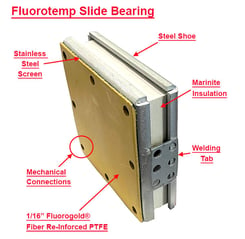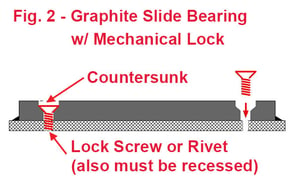In Slide Bearing design as the anticipated operating temperature increases adjustments have to be made to the bearing configuration. At approximately 400°F / 204°C the glue that bonds the Fluorogold® or Teflon® to the backing plate will melt and failure will occur soon afterward.
As an alternative the Fluoroloc Slide Bearing can be used, as this assembly removes any glue, and the Fluorogold® is secured with a stainless steel mesh. This assembly will function efficiently to 500° F.
As operating temperatures exceed 500°F / 260° C there are two different systems a designer may employ to manage the effects of the heat.
Fluorotemp Slide Bearing
 This assembly separates the sliding surface from the heat source. See Fig. 1. Note the assembly is shown vertically for viewing purposes. In actual operation, the yellow Fluorogold would be face down. An outer case is made using a carbon steel upper and lower member separated by a Marinite insulator. Marinite offers a high compressive strength as well as very good thermal resistance. This keeps the heat at the source side of the Slide Bearing and allows the lower member to operate with acceptable temperature limits.
This assembly separates the sliding surface from the heat source. See Fig. 1. Note the assembly is shown vertically for viewing purposes. In actual operation, the yellow Fluorogold would be face down. An outer case is made using a carbon steel upper and lower member separated by a Marinite insulator. Marinite offers a high compressive strength as well as very good thermal resistance. This keeps the heat at the source side of the Slide Bearing and allows the lower member to operate with acceptable temperature limits.
On the sliding surface the Fluorogold® is mechanically connected to the lower case using the Fluoroloc HL system of stainless steel mesh and spot welds. The opposing sliding surface can be Fluoroloc HL or Polished Stainless Steel.
Note in the image, the upper and lower cases are connected with welded tabs on each side to keep the assembly aligned. To minimize heat transfer the tab is as narrow as possible and the tab is perforated to allow heat to disperse.
Fluorotemp Slide Bearings
Load Range : 75 psi to 2,000 psi
Max Operating Temperature :
1/2” thick Marinite to 800° F / 426° C
1” thick Marinite to 1,000° F / 537° C
Graphite Slide Bearing
Graphite can operate at very high temperatures and maintain its effectiveness and durability, so there is no need to separate the surfaces with an insulator. As with the Fluorotemp bearing, adhesive is not used as it will melt due to the operating temperature. The graphite is secured to the backing plate with countersunk screws. See fig. 2. The opposing surface is typically polished stainless steel.
is no need to separate the surfaces with an insulator. As with the Fluorotemp bearing, adhesive is not used as it will melt due to the operating temperature. The graphite is secured to the backing plate with countersunk screws. See fig. 2. The opposing surface is typically polished stainless steel.
Note regarding Graphite : It is more brittle than Fluorogold®. If bent or dropped it can crack. To add strength a Graphite Slide Bearing will usually have a 1/2” thick graphite bearing and at least a 1/4” thick steel backing plate. This protects the graphite and provides a thicker plate for the countersunk screws to anchor to. Once the bearing is installed and under pressure it will not bend or crack and will remain durable for the typical lifespan of the bearing.
Graphite Slide Bearings
Load Range : Maximum 2,000 psi
Max Operating Temperature : 3,000° F / 1,648° C




